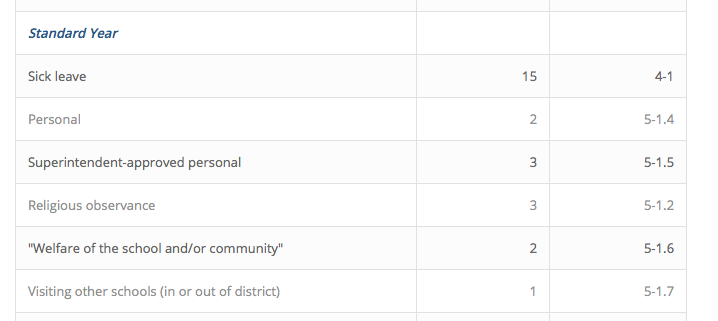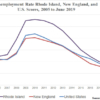PAID FOR NOT WORKING, COLLECTIVE-BARGAINING TAXPAYER RIPOFF #2 : Providence Teacher Leaves of Absence
It is not difficult to understand that if our front-line public servants have incentive to not actually be on the front lines, then the overall quality of those public services will suffer … Mike Stenhouse
In the spring of 2019, the RI Center for Freedom & Prosperity published a major report — Public Union Excesses — detailing the $888 million per year in excessive costs paid by taxpayers due to overly generous collective bargaining provisions in government union contracts at the state and local levels. With two-thirds of these costs absorbed by municipal taxpayers, property taxes could be lowered by as much as 25% if government services were contracted at normal market rates.
Societal Costs. The excessive financial costs to taxpayers may not be as troubling as the social costs resulting from government worker unionization in our state. Union officials have propagated a culture in which extracting every possible dime from taxpayers and dues-payers, regardless of the impact on the quality of the services rendered, appears to be the objective, a culture that inevitably has creeped into the workplace.
Educational Failures. Perhaps no area of government service exemplifies this negative value proposition more clearly than public education. In November 2018, the state released the RICAS student assessment scores, which highlighted the Ocean State’s dismal performance of schools within its public educational system. Furthermore, a July 2018 report showed that Rhode Island schools also suffered from the third-highest teacher absentee rate in the nation.
Connecting the dots, Public Union Excesses clearly lays out the many union contract provisions that provide a disincentive for teachers and other public employees to actually show up for work or perform the vital public services they were hired to conduct at peak levels.
Teacher Attendance. With a national spotlight shining on the government-run Providence public school system for operating what some have characterized as among the worst schools in the country, the lack of consistent and reliable teacher attendance has been in the news. Boston Globe journalist Dan McGowan reports that 500 of the city’s teachers (more than one-quarter) were absent at least 18 times, which is 10% of the school year. That percentage is subtracted from teachers’ 181-day work-year, which is already 21% shorter than the approximate private-sector average work-year of 230.
Parents and interested Rhode Islanders might wonder how this is possible, so the RI Center for Freedom & Prosperity took a look at the Providence Teachers Union contract. Our results are shown in the table below.
In summary, in a standard year, teachers are contractually allowed to take up to 26 days off for a variety of reasons, from sick leave (15 days) to “purposes connected with the welfare of the school and/or community” (2 days). Unlike in the private sector, unused sick days for teachers are allowed to roll over — in full — from year to year, up to 150 days. A teacher can use up to 135 paid days off in one year before facing any consequences.
Common life events like weddings and deaths can add more time to the annual total — 11 days for a year with one of each. Additionally, all teachers are eligible for up to another 11 days for union activities on a rotating and limited basis. Additionally, a union professional development/mentoring coordinator is relieved of teaching duties for one-fifth of the school year, while the union president is relieved for two-fifths; that’s the equivalent of 36 and 72 days each. Adding in the other days off available to all teachers, the union president would be able to not do any actual teaching for the equivalent of 101 of the work year’s 181 days. The Center reported on such absences in our May 2019 “Ghost Workers” report.
On top of this are longer-term and more-rare absences like sabbaticals, quarantine, or job-related-injury leave, which can go for a year or more with pay. Teachers can also take a year at a time off without pay for a number of reasons.
Of course, when a regular teacher is away for a day or for an extended period of time, a substitute teacher must often be hired at additional expense; in Providence it is estimated that substitute teachers cost taxpayers and extra $7 million per year.
These added costs, combined with the reduced quality of education, are one reason why Providence public schools are performing so poorly.
“PAID FOR NOT WORKING” – COLLECTIVELY BARGAINED, ALLOWED TEACHER ABSENCES IN PROVIDENCE
| Number of Days | Contract Citation | |
| Standard Year | ||
| Sick leave | 15 | 4-1 |
| Personal | 2 | 5-1.4 |
| Superintendent-approved personal | 3 | 5-1.5 |
| Religious observance | 3 | 5-1.2 |
| "Welfare of the school and/or community" | 2 | 5-1.6 |
| Visiting other schools (in or out of district) | 1 | 5-1.7 |
| Subtotal | 26 | |
| Life Events1 | ||
| Wedding | 2 | 5-1.1 |
| Bereavement (immediate family) | 5 | 5-2 |
| Bereavement (in-laws) | 3 | 5-2 |
| Bereavement (extended) | 1 | 5-2 |
| Subtotal | 11 | |
| Union Activities (Limited Number of Teachers) | ||
| Delegate to AFL-CIO or other union meetings | 5 | 5-1.3 |
| Negotiating Committee2 | 1 | 16-2.2 |
| Union professional development/mentoring attendance | 5 | 8-30-2 |
| Subtotal | 11 | |
| Total available to any given teacher each year | 48 | |
| Special Union Positions3 | ||
| Union professional development/mentoring coordinator4 | 36 | 8-30-1 |
| Total available to coordinator | 65 | |
| Union president5 | 72 | 5-6 |
| Total available to union president | 101 | |
| Other Events | ||
| Sabbatical | 91 | 5-3 |
| Compulsory Reserve or National Guard | 20 | 5-7.2 |
| Injured on the job | 90 | 6-1 |
| Assault and/or battery on the job | 181 | 6-2 |
| Government tests & examinations | Unlimited | 5-8 |
| Court service | Unlimited | 5-9 |
| Quarantine | Unlimited | 5-10 |
| Without Pay | ||
| Personal | 181 | 5-5.1 |
| Union service | 181 | 5-6 |
| Military leave | 181 | 5-7 |
| Parental/adoption leave | 181 | 5-11 |
| Notes: 1 The “life events” subtotal assumes one of each in a given year. 2 We estimate an average of one day per year in total negotiating time for each teacher on the negotiating committee. Some years, this would be zero, and other years, it could be much higher than 1. 3 The union coordinator and president totals adjust the days available for all teachers so as not to double count their lighter work schedules. 4 The number of days off for the coordinator is the one-fifth schedule reduction applied to the full school year. 5 The number of days off for the president is the two-fifth schedule reduction applied to the full school year. |
||




Leave a Reply
Want to join the discussion?Feel free to contribute!